Haocheng Hua
Hierarchically Tunable 6DMA for Wireless Communication and Sensing: Modeling and Performance Optimization
Mar 03, 2025Abstract:This paper proposes a new hierarchically tunable six-dimensional movable antenna (HT-6DMA) architecture for base station (BS) in future wireless networks. The HT-6DMA BS consists of multiple antenna arrays that can flexibly move on a spherical surface, with their three-dimensional (3D) positions and 3D rotations/orientations efficiently characterized in the global spherical coordinate system (SCS) and their individual local SCSs, respectively. As a result, the 6DMA system is hierarchically tunable in the sense that each array's global position and local rotation can be separately adjusted in a sequential manner with the other being fixed, thus greatly reducing their design complexity and improving the achievable performance. In particular, we consider an HT-6DMA BS serving multiple single-antenna users in the uplink communication or sensing potential unmanned aerial vehicles (UAVs)/drones in a given airway area. Specifically, for the communication scenario, we aim to maximize the average sum rate of communication users in the long term by optimizing the positions and rotations of all 6DMA arrays at the BS. While for the airway sensing scenario, we maximize the minimum received sensing signal power along the airway by optimizing the 6DMA arrays' positions and rotations along with the BS's transmit covariance matrix. Despite that the formulated problems are both non-convex, we propose efficient solutions to them by exploiting the hierarchical tunability of positions/rotations of 6DMA arrays in our proposed model. Numerical results show that the proposed HT-6DMA design significantly outperforms not only the traditional BS with fixed-position antennas (FPAs), but also the existing 6DMA scheme. Furthermore, it is unveiled that the performance gains of HT-6DMA mostly come from the arrays' global position adjustments on the spherical surface, rather than their local rotation adjustments.
An Overview on IEEE 802.11bf: WLAN Sensing
Oct 20, 2023Abstract:With recent advancements, the wireless local area network (WLAN) or wireless fidelity (Wi-Fi) technology has been successfully utilized to realize sensing functionalities such as detection, localization, and recognition. However, the WLANs standards are developed mainly for the purpose of communication, and thus may not be able to meet the stringent requirements for emerging sensing applications. To resolve this issue, a new Task Group (TG), namely IEEE 802.11bf, has been established by the IEEE 802.11 working group, with the objective of creating a new amendment to the WLAN standard to meet advanced sensing requirements while minimizing the effect on communications. This paper provides a comprehensive overview on the up-to-date efforts in the IEEE 802.11bf TG. First, we introduce the definition of the 802.11bf amendment and its formation and standardization timeline. Next, we discuss the WLAN sensing use cases with the corresponding key performance indicator (KPI) requirements. After reviewing previous WLAN sensing research based on communication-oriented WLAN standards, we identify their limitations and underscore the practical need for the new sensing-oriented amendment in 802.11bf. Furthermore, we discuss the WLAN sensing framework and procedure used for measurement acquisition, by considering both sensing at sub-7GHz and directional multi-gigabit (DMG) sensing at 60 GHz, respectively, and address their shared features, similarities, and differences. In addition, we present various candidate technical features for IEEE 802.11bf, including waveform/sequence design, feedback types, as well as quantization and compression techniques. We also describe the methodologies and the channel modeling used by the IEEE 802.11bf TG for evaluation. Finally, we discuss the challenges and future research directions to motivate more research endeavors towards this field in details.
Near-Field 3D Localization via MIMO Radar: Cramér-Rao Bound Analysis and Estimator Design
Aug 30, 2023Abstract:This paper studies a near-field multiple-input multiple-output (MIMO) radar sensing system, in which the transceivers with massive antennas aim to localize multiple near-field targets in the three-dimensional (3D) space over unknown cluttered environments. We consider a spherical wavefront propagation with both channel phase and amplitude variations over different antennas. Under this setup, the unknown parameters include the 3D coordinates and complex reflection coefficients of the targets, as well as the noise and interference covariance matrix. First, by considering general transmit signal waveforms, we derive the Fisher information matrix (FIM) corresponding to the 3D coordinates and the complex reflection coefficients of the targets and accordingly obtain the Cram\'er-Rao bound (CRB) for the 3D coordinates. This provides a performance bound for 3D near-field target localization. For the special single-target case, we obtain the CRB in an analytical form, and analyze its asymptotic scaling behaviors with respect to the target distance and antenna size of the transceiver. Next, to facilitate practical localization, we propose two estimators to localize targets based on the maximum likelihood (ML) criterion, namely the 3D approximate cyclic optimization (3D-ACO) and the 3D cyclic optimization with white Gaussian noise (3D-CO-WGN), respectively. Numerical results validate the asymptotic CRB analysis and show that the consideration of varying channel amplitudes is vital to achieve accurate CRB and localization when the targets are close to the transceivers. It is also shown that the proposed estimators achieve localization performance close to the derived CRB under various cluttered environments, thus validating their effectiveness in practical implementation. Furthermore, it is shown that transmit waveforms have a significant impact on CRB and the localization performance.
Near-Field 3D Localization via MIMO Radar: Cramér-Rao Bound and Estimator Design
May 18, 2023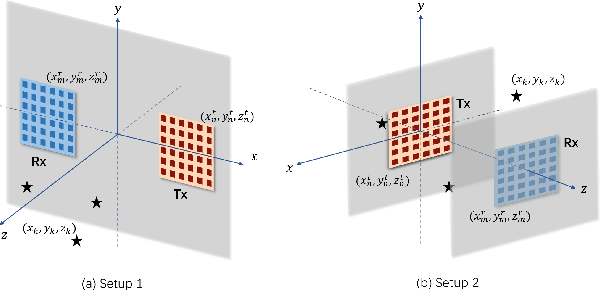
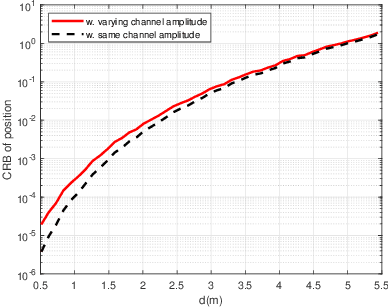
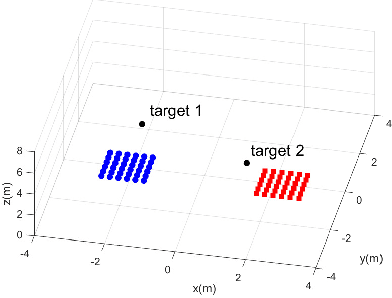
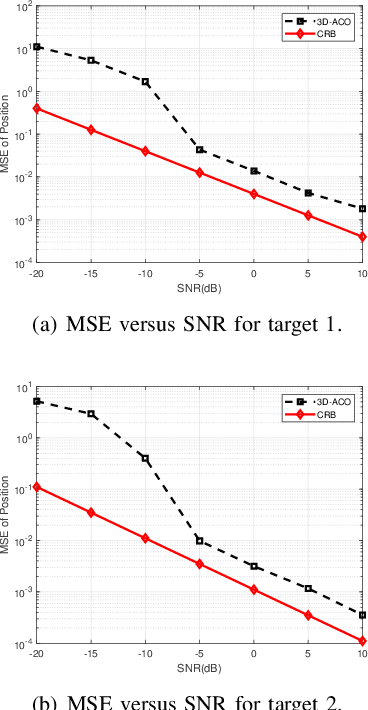
Abstract:Future sixth-generation (6G) networks are envisioned to provide both sensing and communications functionalities by using densely deployed base stations (BSs) with massive antennas operating in millimeter wave (mmWave) and terahertz (THz). Due to the large number of antennas and the high frequency band, the sensing and communications will operate within the near-field region, thus making the conventional designs based on the far-field channel models inapplicable. This paper studies a near-field multiple-input-multiple-output (MIMO) radar sensing system, in which the transceivers with massive antennas aim to localize multiple near-field targets in the three-dimensional (3D) space. In particular, we adopt a general wavefront propagation model by considering the exact spherical wavefront with both channel phase and amplitude variations over different antennas. Besides, we consider the general transmit signal waveforms and also consider the unknown cluttered environments. Under this setup, the unknown parameters to estimate include the 3D coordinates and the complex reflection coefficients of the multiple targets, as well as the noise and interference covariance matrix. Accordingly, we derive the Cram\'er-Rao bound (CRB) for estimating the target coordinates and reflection coefficients. Next, to facilitate practical localization, we propose an efficient estimator based on the 3D approximate cyclic optimization (3D-ACO), which is obtained following the maximum likelihood (ML) criterion. Finally, numerical results show that considering the exact antenna-varying channel amplitudes achieves more accurate CRB as compared to prior works based on constant channel amplitudes across antennas, especially when the targets are close to the transceivers. It is also shown that the proposed estimator achieves localization performance close to the derived CRB, thus validating its superior performance.
Joint transmit and reflective beamforming for IRS-assisted integrated sensing and communication
Nov 26, 2021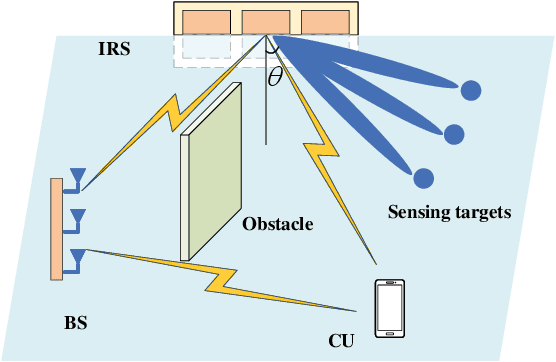
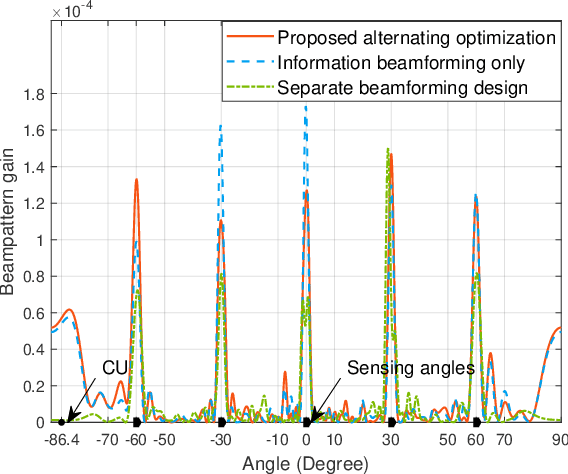
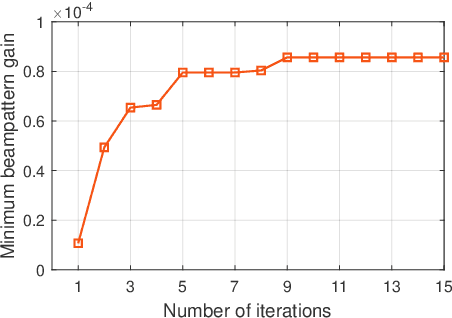
Abstract:This letter studies an intelligent reflecting surface (IRS)-assisted integrated sensing and communication (ISAC) system, in which one IRS is deployed to not only assist the wireless communication from a multi-antenna base station (BS) to a single-antenna communication user (CU), but also create virtual line-of-sight (LoS) links for sensing targets at areas with LoS links blocked. We consider that the BS transmits combined information and sensing signals for ISAC. Under this setup, we jointly optimize the transmit information and sensing beamforming at the BS and the reflective beamforming at the IRS, to maximize the IRS's minimum beampattern gain towards the desired sensing angles, subject to the minimum signal-to-noise ratio (SNR) requirement at the CU and the maximum transmit power constraint at the BS. Although the formulated SNR-constrained beampattern gain maximization problem is non-convex and difficult to solve, we present an efficient algorithm to obtain a high-quality solution using alternating optimization and semi-definite relaxation (SDR). Numerical results show that the proposed algorithm achieves improved sensing performance while ensuring the communication requirement.
 Add to Chrome
Add to Chrome Add to Firefox
Add to Firefox Add to Edge
Add to Edge